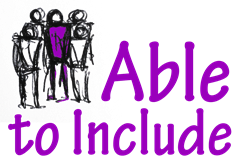ABLE-TO-INCLUDE will achieve the following specific objectives:
- Create an open-source context aware accessibility layer for people with Intellectual and Developmental Disabilities (IDD), based on the integration and composition of at least 3 technologies:
- Text and content simplifier (Simplext technology, developed by partners ASI and UPF)
- A pictogram-text, text-pictogram and pictogram-pictogram translation tool (WAI-NOT technology, developed by partners KU Leuven and TM)
- Text-to-speech functionalities (open-source available solutions)
- Create an open source Software Developer Kit (SDK) supporting the technical integration of the accessibility layer for people with intellectual disabilities with existing and future ICT applications.
- Adapt the already-developed technologies for their use in the pilots:
- The current version of the text Simplext simplifier has been created and extensively tested in Spanish. The tool will be adapted forABLE-TO-INCLUDE to be used in English. Rules, grammar, thesaurus will be revised in order to use it in another language.
- Currently, the state of the pictogram translation tool WAI-NOT is already completely functional for Dutch and two sets of pictograms: the Dutch versions of Beta and Sclera. During the project it will be translated into English and Spanish, and allowing translation to the Spanish and English versions of Sclera pictograms.
- Promote the use of augmented and alternative communication tools based on the accessibility layer.
- Validate the integration of the accessibility layer with existing ICT applications involving at least 300 people with IDD (100 per country) in three usage scenarios
- Leisure (Spain, UK, Belgium): Integration of the accessibility layer with at least three ICT applications for social communications, preferably Facebook, Twitter, Whatsapp.
- Transport (Belgium, UK): Integration of the accessibility layer with an urban transport guidance system smart phone app for people with IDD.
- Labour Inclusion (Spain): Integration of the accessibility layer with the three key technologies (Simplext, WAI-NOT and text-to-speech) used by people with IDD working as administrative assistants.
- Successfully deploy and coordinate an open innovation process for the creation and engagement of an open-innovation community in the development and long-term sustainability of ABLE-TO-INCLUDE project
- Successfully impact the accessibility of current and future ICT applications by generating a prosperous open innovation ecosystem around the release of the accessibility layer as an open source system.
- Generate a global business plan for the future exploitation of the accessibility layer
